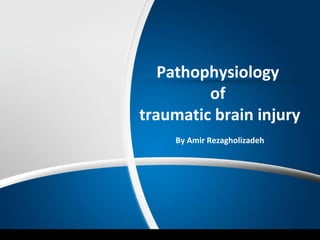
Pathophysiology of traumatic brain injury
- 1. Pathophysiology of traumatic brain injury By Amir Rezagholizadeh
- 2. Reference 2
- 3. Outline • Introduction • Etiology • Classification • Symptoms • General pathophysiology of TBI • Specific pathophysiology of TBI • References 3
- 4. Introduction • Traumatic brain injury (TBI) is physical injury to brain tissue that temporarily or permanently impairs brain function. TBITBI PDPD ADAD HIVHIV 4
- 6. Classification TBITBI moderate Occurrenc e Location mild moderate severe Primary severity Secondary DiffuseFocal 6
- 7. • Traumatic brain injury is graded as mild, moderate, or severe on the basis of the level of consciousness or Glasgow coma scale (GCS) . Classification 7
- 8. • Head Injuries are commonly the basis of Occurrence categorized (a) primary damage, mechanical damage (b) secondary damage, delayed non-mechanical damage Classification 8
- 9. • TBI are the basis of location classified as (a) focal brain damage (b) diffuse brain damage Classification 9
- 11. Symptoms SLEEP DYSREGULATION Trouble falling asleep Overnight awakening Too much/too little sleep MOOD DISRUPTION Irritability Sadness Anxiety Physical Headaches Dizziness Light/noise sensitivity Fatigue/tiredness COGNITIVE Fogginess Concentration Memory deficits Cognitive fatigue 11
- 12. • The first stage of the pathophysiological cascade Direct tissue damage impairedDirect tissue damage impaired regulation ofregulation of CBF and metabolismCBF and metabolism Direct tissue damage impairedDirect tissue damage impaired regulation ofregulation of CBF and metabolismCBF and metabolism ‘‘Ischaemia-like’ patternIschaemia-like’ pattern‘‘Ischaemia-like’ patternIschaemia-like’ pattern Accumulation of lactic acidAccumulation of lactic acidAccumulation of lactic acidAccumulation of lactic acidIncreased membraneIncreased membrane permeabilitypermeability Increased membraneIncreased membrane permeabilitypermeability Oedema formationOedema formationOedema formationOedema formation General pathophysiology of TBI 12
- 13. • The second stage of the pathophysiological cascade General pathophysiology of TBI 13
- 14. Specific pathophysiology of TBI Cerebral blood flow: •Studies in laboratory animals and humans have investigated the effects of TBI on CBF . •CBF α CPP •CPP = MAP – ICP 14
- 15. Specific pathophysiology of TBI ischemic Uncoupling CBF and metabolism Increase ICP Decrease CPP Decrease CBF 15
- 16. Cerebral vasospasm : •Vasospasm occurs in more than one-third of patients with TBI and indicates severe damage to the brain . •Hypoperfusion occurs in 50% of all patients developing vasospasm. Specific pathophysiology of TBI 16
- 17. Specific pathophysiology of TBI depolarization of vascular smooth muscle reduced nitric oxide prostaglandin cyclic GMP depletion Release endothelin vasospasm The mechanisms by which vasospasm occurs 17
- 18. Cerebral metabolic dysfunction •Cerebral metabolism and cerebral energy state frequently reduced after TBI . •The reduction in post-traumatic cerebral metabolism relates to intramitochondrial Ca2+ overload , the mitochondrial dysfunction with reduced ATP-production and reduced availability of the nicotinic co-enzyme pool . Specific pathophysiology of TBI 18
- 19. release of excitatory neurotransmitter release of excitatory neurotransmitter over- stimulation of receptor over- stimulation of receptor CaCa2+2+ , Na, Na++ , and, and KK++ -fluxes-fluxes CaCa2+2+ , Na, Na++ , and, and KK++ -fluxes-fluxes trigger catabolic processes trigger catabolic processes increases Na+ K+ ATPase activity increases Na+ K+ ATPase activity flow–metabolism uncoupling flow–metabolism uncoupling Specific pathophysiology of TBI Excitotoxicity 19
- 20. Oxidative stress •Oxidative stress relates to the generation of reactive oxygen species in response to TBI . •The excessive production of reactive oxygen species due to excitotoxicity and exhaustion of the endogenous antioxidant system . •Reactive oxygen species induces peroxidation of cellular and vascular structures, protein oxidation, cleavage of DNA, and inhibition of the mitochondrial electron transport chain . Specific pathophysiology of TBI 20
- 21. Oedema Specific pathophysiology of TBI Cytotoxic brain oedema increased cell membrane permeability for ions, ionic pump failure due to energy depletion Vasogenic brain oedema functional breakdown of the endothelial cell layer Increase ICP 21
- 22. Inflammation •Damage to the endothelium of blood vessels is a known pathway for initiation of inflammation . •Both primary and secondary insults activate the release of cellular mediators including proinflammatory cytokines, prostaglandins and free radicals . •Proinflammatory enzymes such as tumour necrosis factor, interleukin-1-ß, and interleukin-6 are upregulated within hours from injury. Specific pathophysiology of TBI 22
- 23. Necrosis vs apoptosis • Necrosis occurs in response to severe mechanical or ischaemic/ hypoxic tissue damage with excessive release of excitatory amino acid neurotransmitters and metabolic failure. •The nature of apoptosis generally requires energy supply and imbalance between naturally occurring pro- and anti-apoptotic proteins. •Caspases have been idientified as the most important mediators of programmed cell death. Specific pathophysiology of TBI 23
- 24. References • Werner, C., & Engelhard, K. (2007). Pathophysiology of traumatic brain injury. British journal of anaesthesia, 99(1), 4- 9. • Mustafa, Ayman G., and Othaman A. Alshboul. "Pathophysiology of traumatic brain injury." Neurosciences 18.3 (2013): 222-234. • Prins, Mayumi, et al. "The pathophysiology of traumatic brain injury at a glance." Disease models and mechanisms 6.6 (2013): 1307-1315. 24
- 25. Thank you for your attention 25
- 26. 26